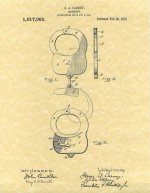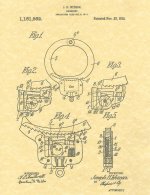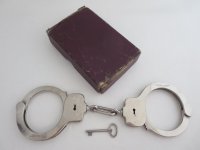dltvette
US Veteran
Feb. 20 is National Handcuff Day.
Beginning in 2010, February 2oth of each year, is known as, National Handcuff Day.
It is on this date, February 20, 1912, that the US Patent Office issued patent number 1,017,955 to George A. Carney of Boston, in the county of Suffolk and Commonwealth of Massachusetts for his invention of a “swinging bow, ratchet-type” adjustable handcuff that has been the pattern for most modern handcuffs since this patent had been filed.
James Milton Gill, the Police Commissioner of Springfield, Massachusetts, purchased this patent from George A. Carney, and on June 22, 1914, he formed and incorporated the Peerless Handcuff Company of Springfield, Massachusetts.
James M. Gill, not having manufacturing experience, enlisted the help of his friend Joseph H. Wesson, one of the partners in the Smith & Wesson firearms company, to help him with the task of manufacturing his newly acquired patent. The lock mechanism of the Carney patent was not sufficient for restraining purposes, so Joseph Wesson designed an “Improved Lock” mechanism to be used in the Carney swing through patent handcuff. This patent was filed on October 6, 1914, and on November 23, 1915, patent number 1,161,562 was granted to Joseph H. Wesson and assigned to James M. Gill.
The first handcuffs offered by The Peerless Handcuff Company, manufactured by Smith & Wesson with the patent date Feb. 20, 1912 using Carney’s patent and Wesson’s improved lock patent was manufactured in 1914-15.
These are known to collectors as the Patent Model.
The example shown here, I acquired from the Roy Jinks collection, that he rescued from the Smith & Wesson Factory. These evidently were never shipped to the Peerless Handcuff Company and could very well be the prototype example. They were manufactured having two right hand cuffs connected by one large chain link. The front, keyway side was stamped, MFGD BY SMITH & WESSON PAT. FEB. 20.1912 and the rear side was stamped, THE PEERLESS HANDCUFF CO. SPRINGFIELD MASS.
Also shown is George Carney’s patent no. 1,017,955 drawing and Joseph Wesson’s patent no. 1,161,562 drawing of the improved lock mechanism used to manufacture this new handcuff design.
Thanks for taking the time to read this post and celebrating the National Handcuff Day, on February 20, 2018.
Dave
Beginning in 2010, February 2oth of each year, is known as, National Handcuff Day.
It is on this date, February 20, 1912, that the US Patent Office issued patent number 1,017,955 to George A. Carney of Boston, in the county of Suffolk and Commonwealth of Massachusetts for his invention of a “swinging bow, ratchet-type” adjustable handcuff that has been the pattern for most modern handcuffs since this patent had been filed.
James Milton Gill, the Police Commissioner of Springfield, Massachusetts, purchased this patent from George A. Carney, and on June 22, 1914, he formed and incorporated the Peerless Handcuff Company of Springfield, Massachusetts.
James M. Gill, not having manufacturing experience, enlisted the help of his friend Joseph H. Wesson, one of the partners in the Smith & Wesson firearms company, to help him with the task of manufacturing his newly acquired patent. The lock mechanism of the Carney patent was not sufficient for restraining purposes, so Joseph Wesson designed an “Improved Lock” mechanism to be used in the Carney swing through patent handcuff. This patent was filed on October 6, 1914, and on November 23, 1915, patent number 1,161,562 was granted to Joseph H. Wesson and assigned to James M. Gill.
The first handcuffs offered by The Peerless Handcuff Company, manufactured by Smith & Wesson with the patent date Feb. 20, 1912 using Carney’s patent and Wesson’s improved lock patent was manufactured in 1914-15.
These are known to collectors as the Patent Model.
The example shown here, I acquired from the Roy Jinks collection, that he rescued from the Smith & Wesson Factory. These evidently were never shipped to the Peerless Handcuff Company and could very well be the prototype example. They were manufactured having two right hand cuffs connected by one large chain link. The front, keyway side was stamped, MFGD BY SMITH & WESSON PAT. FEB. 20.1912 and the rear side was stamped, THE PEERLESS HANDCUFF CO. SPRINGFIELD MASS.
Also shown is George Carney’s patent no. 1,017,955 drawing and Joseph Wesson’s patent no. 1,161,562 drawing of the improved lock mechanism used to manufacture this new handcuff design.
Thanks for taking the time to read this post and celebrating the National Handcuff Day, on February 20, 2018.
Dave
Attachments
Last edited:









